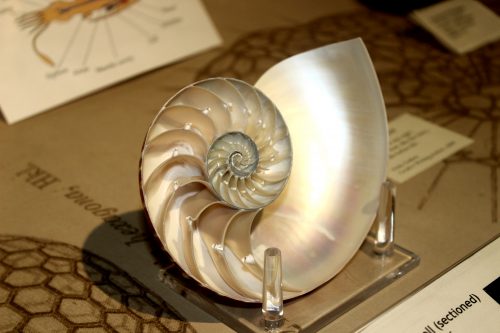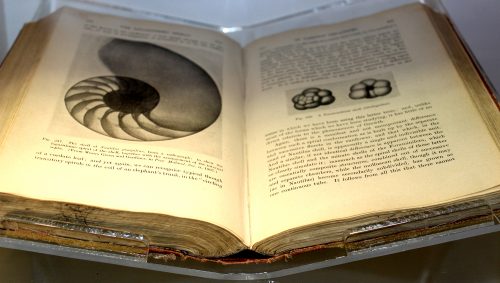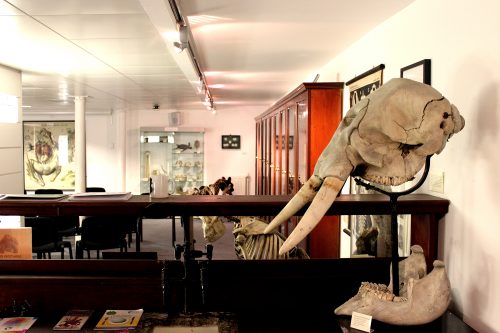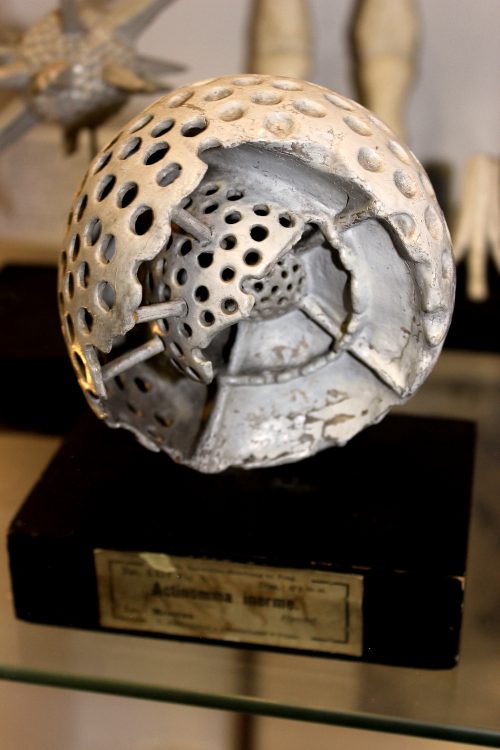On Growth and Form at 100: An interview with Matthew Jarron
Posted by Aidan Maartens, on 28 November 2017
In late September I boarded a tiny propeller plane to Dundee to meet Matthew Jarron, who curates the University of Dundee’s D’Arcy Thompson Zoology Museum. We had seen Matthew speak about On Growth and Form at a Royal Society event over the summer, and realised he would be a perfect person to interview to give the work some context in our special issue celebrating its centenary (published today!). On the taxi from the airport, through the fog I could just about make the Tay Rail Bridge, which was rebuilt in 1887 after collapsing in a storm in 1879. D’Arcy Thompson’s book contains a section comparing dinosaur skeletons to railway bridges – how does the form of an object reflect the mechanical strains placed on it? – so I could almost imagine a sleeping dinosaur stretching south towards St. Andrews. Matthew was a great source of insight into the book and the man behind it; I’d encourage anyone who visits Dundee to go see the museum and its wonderful collection of items, many of which inspired Thompson’s ideas.

D’Arcy Thompson was born in 1860, trained in Edinburgh and Cambridge, and held positions in Dundee and St Andrews, where he worked until his death in 1948. On Growth and Form, his classic work on the mathematical patterns and physical rules underlying biological forms, was first published in 1917. To learn more about the book’s context, we met Matthew Jarron, Curator of Museum Services at the University of Dundee, in the University’s D’Arcy Thompson Zoology Museum. Surrounded by specimens, many of which were collected by Thompson himself, we discussed the legacy of On Growth and Form and the life of the man behind it.
Matthew, can you tell me how you first came to encounter D’Arcy Thompson’s work?
Before I came to Dundee, I was a curator of a local history museum in St Andrews, which had been gifted a medicine chest from his days as a student in Edinburgh by the last surviving of his three daughters. This wonderful chest was my first encounter with D’Arcy, and as I gradually read more stories about him, I realised what a fascinating character he was. When I came to Dundee, I discovered we had what was left of his zoology collection. This was once one of the largest collections of zoological specimens in the country but had become dispersed in various displays and was not really accessible to the public. It wasn’t until the department of Life Sciences moved building in 2007 that we were able to create a proper version of the museum, have it open to the public and start telling people more about D’Arcy’s work. The more I read about him, the more I realised how incredible his influence has been in so many different fields in biology and beyond. In the museum, we’ve been very keen to use his collection in as many different ways as we can, to get people interested in his life and work. The centenary of his book has provided a great opportunity to do that, and you can find out about the various celebratory events here in Dundee as well as globally on the anniversary website (www.ongrowthandform.org/).
How did the idea for On Growth and Form come about?
From very early childhood, D’Arcy was fascinated by the natural world, partly because a number of his family were vets, but also because his father was a great classical scholar and had introduced him to classical biologists like Aristotle. Originally, he went to Edinburgh University to study medicine, but quite quickly realised that he wanted to specialise in biology, and transferred to Cambridge, which was really the only place where you could focus on the natural sciences at the time. He came to the University of Dundee (known then as University College Dundee, which had opened in 1883) at a very early age – he was only 24 when he was appointed to the first chair of biology in 1884. It was quite a small university, but they assembled a really extraordinary and dynamic group who were able to think in interdisciplinary ways. So, from very early on I think he had that broader interest, paired with his classical training and the associated idea that naturalists could look at broader themes.
As for On Growth and Form, we know that in 1889 he wrote a letter to one of his students saying that he had taken to mathematics. He had been looking at foraminifera, single-celled organisms that grow these extraordinary ‘tests’ (external shells) that often form geometric shapes, and he realised that there were very specific patterns that kept recurring. That was probably when he started to think that not everything in biology could be explained by Darwin’s ideas of evolution, which by that point had become quite widely accepted. These foraminifera, which presumably had similar evolutionary pressures, adopted quite diverse geometric forms; for D’Arcy this suggested that there was clearly something more going on here. He began to think about the physical forces acting on these organisms and realised that they formed specific mathematical patterns during their development.
Thompson started to think that not everything in biology could be explained by Darwin’s ideas of evolution
At the time he realised that these ideas would be quite controversial, and also that no one would really have much interest in applying them. He wasn’t completely keeping it to himself, but it wasn’t until 1908 that he published anything at all – a paper in Nature on the shape of eggs. Then, in 1915, he published a fairly substantial paper in the Royal Society of Edinburgh’s Transactions called ‘Mathematics and Morphology’, which is essentially what forms the final and most celebrated chapter of On Growth and Form. In 1911, he had been asked by Cambridge University Press to write a small book on the biology of growth and form. They had a series of popular science works that cost something like a shilling and were perhaps a hundred pages long, but as he started writing, it just got bigger and bigger, taking many years to write, and when he finally sent the text back to Cambridge they must have been somewhat horrified to find how enormous it had become! They did, however, agree to publish it separately.

And what does the book actually contain?
D’Arcy introduces the book with his case for looking at biology from a mathematical standpoint, to understand form from the point of view of physics and of mathematical laws, even though this was something that naturalists didn’t particularly want to do. The next chapter is concerned with size, and he makes the point that gravitational forces are much more important at larger scales, while surface forces, and in particular surface tension, play a much more important role at smaller scales. He starts with the smallest organisms, individual cells and their internal structures, and gradually works his way up, for instance exploring how the formation of clusters of cells is analogous to how soap bubbles come together. Throughout the book, and particularly here, he takes an organic form and compares it with an inorganic one; where he sees the same patterns, he reasons that the same physical forces are causing these shapes to appear. He goes on to look at individual parts of organisms – for instance the shells of foraminifera and nautilus, or antlers, horns and tusks – and explores how growth rates might cause their different curves and spirals. Then he looks at larger organisms, and famously compares the structure of quadruped skeletons with the structure of bridges. There is a chapter (which is missed out of the abridged edition) on plants and their phyllotaxis in relation to the Fibonacci sequence, and then in the final chapter he presents his theory of transformations. When dealing with large entire organisms, he admits he clearly can’t explain all their differences through mathematics, but he can take two related organisms and see how one could mathematically have changed into the other. He looks at the organism as a system, and explores how that whole system will transform; the famous diagrams are his attempt to explain that. He ends the book by saying that what he has described in the book is ‘a field which few have entered and no man has explored’.

How was the book received?
When the book came out it was very widely praised. Everyone was hugely impressed by the vastness of his learning; one of the most extraordinary things about the work is how he brings together examples from recent research with examples from ancient history, that he views the biology of Aristotle as equally relevant to the biology of the time. There were reviews of the book not only in biology but also in engineering journals, as well as Country Life of all places, and I think this reflects a recognition that the ideas in the book could have a much wider application. But it’s notable that many of the reviewers were basically saying how well written it was, rather than how it was going to transform biology. While an enormous amount of learning had gone into the work, very few people could actually grasp how to take it forward. A key issue was that many biologists didn’t really know much mathematics; similarly, he struggled to get many mathematicians interested in the work. But there were some key people who picked up on the book and took forward the idea of mathematical biology, and with whom D’Arcy was in regular correspondence. Interestingly, these people were often working in different fields and using completely different kinds of mathematics from D’Arcy’s; for instance, early ecologists interested in using mathematical models to look at populations.

More and more people appear to be turning back to his work and finding useful things in it today
The first edition had sold out in 1923 – as far as we know it was limited to 500 copies, one of which is displayed here in the museum – but it was 20 years before he got round to writing his second edition. It’s no coincidence that both editions were published during wartime – it was only then that he had time to write, as so many of his students were away at the front and his administrative role lightened. The second edition includes more illustrations and examples – for instance, a section on animal coat markings that was a key influence on Alan Turing – but it does not actually contain that many new areas of research. In particular, he was criticised for ignoring all the developments in genetics since the first edition was published. It wasn’t that he didn’t know anything about genetics – he was completely up to speed with everything that was going on – rather, it was that he couldn’t see how he could incorporate the work into his thesis, and so he just ignored it. While he could get away with this in the first edition, by the time of the second edition it was less easy, and that rather doomed his work for a lot of biologists. Conversely, while the second edition was problematic for some biologists, it got very quickly picked up by artists, engineers, architects, geographers and anthropologists. So from the 1950s there was a renewed interest that slowly picked up, until recently when it seems to have taken off exponentially. It’s quite amazing that more and more people appear to be turning back to his work and finding useful things in it today.
The book argues that one can look at biology through a mathematical lens – what type of mathematics did Thompson employ?
The mathematics he knew was pretty much all classical: geometry and algebra. He certainly didn’t have any kind of detailed knowledge of contemporary mathematics, and indeed he acknowledges that himself. I think it was a real problem for him, but he just didn’t have the time to get into detailed mathematics of the kind that later biomathematicians did. He probably did not have the inclination either: I don’t think he ever felt that mathematical biology was the topic he’d spend the rest of his life on, as his main interest was in fisheries. Indeed most of his work was taken up with international diplomacy about fishing quotas and that sort of thing; he was well known as a great diplomatist in helping to resolve disputes while countries were dividing up the sea for different fishing rights. With On Growth and Form, he felt that he’d opened a gate into this new field, and was happy for other people to go in and explore it.
Richard Dawkins once said it was a great shame that the computer wasn’t invented in D’Arcy’s lifetime because his work cries out for it, and perhaps this is one of the reasons why so few people at the time actually picked up on what he was doing. It took more sophisticated mathematicians like Alan Turing and the development of computers to allow you to test these theories and build models.
What do you think are the book’s key contributions?
Largely, I think it’s the general idea that you can apply mathematics to biology. This has been so influential in biology as a whole, and particularly now in developmental biology, where its specific influence might not have been that great at the time. His holistic approach was influential for the whole organicist tradition of biology, and particularly for people like Conrad Hal Waddington, who was enormously influenced by the book and whose ideas about epigenetics have become so crucial to development. The idea of taking this vast and complex world of nature and reducing it down to fundamental rules is also obviously a key part of systems theory, and was hugely influential in its development, not to mention cybernetics and the start of computing, artificial intelligence and so on. These are all linked to D’Arcy’s work, and his ideas are still influential in art, architecture, geography and anthropology. Actually there are whole new areas of science that trace an influence back to him – things like nanochemistry; one of the field’s pioneers, Geoffrey Ozin, credits D’Arcy as an inspiration. It’s clearly something that people in a wide range of fields are continually coming back to, even if they are just taking general ideas rather than specifics.

Considering Stephen J. Gould’s opinion that biologists regarded On Growth and Form as ‘an unusable masterpiece doomed by excessive length and difficulty of application’, why should the modern reader pick it up?
It certainly is the case that very few people have read the book from cover to cover, in order, but in a sense that doesn’t really matter. For me there are two reasons to pick it up: one is that even if you’re never going to read through the mathematical bits, or the stretches of Latin, Greek and German that he doesn’t bother to translate for you, there are lots of very beautiful, poetic passages that still read very well, and which are just inspiring; the other is that it has so many amazing illustrations that are also just as inspirational. Frankly, if all you do is pick it up, flick through it and look at the pictures, that’s great – you’ll still be inspired by the mathematical beauty of nature, as D’Arcy wants you to be. There’s still lots there for the modern reader.
And what about D’Arcy the man – you’ve read much of his correspondence and what people wrote about him. Do you have any feel for his personality?
He had a great personality, and was a larger than life character in every sense. For one thing he was a large, tall man, standing six foot three, described as a veritable lion due to his beard. His students loved him as an eccentric teacher who would use bizarre props to help illustrate his points. There are many anecdotes about how learned he was, how in tutorials he would translate from Medieval Italian, that kind of thing. I think he had a great sense of humour, which certainly comes across in letters to his friends. He corresponded with so many different people, and though he was this great diplomatist, always very polite to people, when he was speaking to his closest friends he could be incredibly and hilariously rude about others! He was also a great populariser of science – he loved giving public lectures, and talking to children and showing them round his museum. Famously, in his old age he had a pet parrot that perched on his shoulder as he wandered the streets of St Andrews. So by all accounts he was a great character.
In a sense he was the last of an era. In the 19th century, it was quite common to have great erudite polymaths, but in the 20th century less so. I think he very much felt of himself as a man out of time, and this was perhaps one of the reasons he loved classics so much – he looked back on great figures like Aristotle who could take a broad look at life. The breadth of his knowledge was extraordinary, and he was constantly championing ideas of interdisciplinarity and emphasising how important it is to look beyond your own field. Holistic overviews like the one provided by D’Arcy are, I think, still important, and it would be a shame if we totally lost them.
Do you think there are any misconceptions about D’Arcy Thompson and his work?
Well, one is that he is somehow anti-evolution. It’s not that he thinks that evolution is wrong or doesn’t exist, it’s just that he’s saying that Darwinian evolution can’t explain everything. The transformation diagrams were, I guess, the part that most obviously appeared to contradict Darwinian evolution – whereas Darwin emphasised slow, gradual change, with each particular part responding to natural selection, D’Arcy says that that can’t always be the case, and there must have been times when there was more of a sudden transformation from one kind to another. But even if you argue with this point, his work emphasises that, however something evolves, it will evolve according to certain mathematical patterns.
There’s also a general misconception – and of course I’d say this being here in Dundee – that he was some kind of maverick loner in a remote backwater writing this book without any support. This simply isn’t true – he drew hugely on his fellow professors here in Dundee; for instance, the engineering professor Thomas Claxton Fidler helped him with his ideas of dinosaurs and bridges, and the physics professor William Peddie was enormously valuable in helping to shape the entire book.
If Thompson were alive today, what would you ask him?
From a purely personal point of view, working here in the museum, I would ask him where he got each one of these specimens – he never catalogued his museum, it was just all in his head! Occasionally, we’ll find a letter where he’ll describe some gorilla he’d just acquired, but for a vast amount of stuff we just have no written record.
The other thing I find mysterious about him was his position on the great debates in biology at the time around ideas of vitalism, mechanism and organicism. It is never entirely clear where D’Arcy sits with regard to them – on the one hand, On Growth and Form seems to be quite a mechanistic book, reducing nature down to rules, but at the same time D’Arcy is very keen to point out that mechanism doesn’t have all the answers, that there are things that you can’t explain in nature. In that sense, he takes elements of vitalism, while a lot of the organicists saw him as a key influence. It probably comes back to his diplomacy – he very deliberately doesn’t come down on one side or the other. So I’d like to sit him down in a room and find out what he really thought about these issues.
On Growth and Form at 100 on the Node:
Morphogenesis one century after On Growth and Form


 (1 votes)
(1 votes)
A brilliant account of the amazing work of D’Arcy Thompson. Athough I studied Botany in St Andrews, I do not remember his name being mentioned, and am only reading about him in preparing a small exhibition in the Preservation Museum of St Andrews. I am sorry his incredible approach to understanding living organisms did not feature in my undergraduate course.